
Saturday’s ad is another one for Rheingold Beer, this one from 1954, and features Miss Rheingold from that year, Adrienne Garrett. In this ad, she’s gardening in her matching apron (or is that a skirt?) and gloves.

By Jay Brooks
By Jay Brooks
By Jay Brooks
By Jay Brooks
![]()
Happy “Independence Eve” everybody. If you’ve never heard of “Independence Eve,” that’s because Newcastle Brown Ale made it up. But it’s so brilliant, I’m going to start observing it, and maybe even will start a tradition of drinking a British ale every July 3. Perhaps even a Newcastle Brown Ale just to say thanks for this hilarious series of ads.
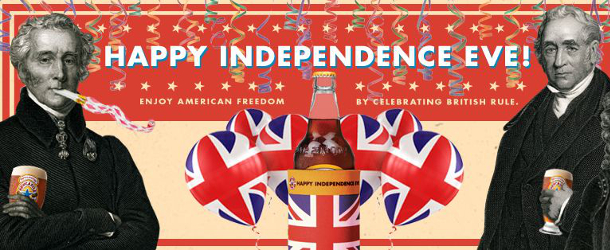
There’s maybe fifteen ads on YouTube or at the dedicated website Newcastle set up for the promotion: If We Won. The latest is below, though I’d encourage you to go back and watch them all. Here’s the most recent one, and they keep adding news ones every few hours.
And here’s another favorite one, with Britsh comedian and writer Stephen Merchant. There’s also ones with Elizabeth Hurley and Zachary Quinto. You can check out all fifteen (at last count) at Newcastle’s YouTube channel.
AdWeek has a story about the advertising campaign, Newcastle Ambushes July 4 by Inventing ‘Independence Eve,’ Celebrating British Rule The Redcoats Get Revenge. From the article:
British brands, understandably, don’t have much to say around the Fourth of July—until now. Newcastle Brown Ale, among the cheekiest of U.K. marketers, has turned America’s most patriotic holiday to its advantage by inventing a new, completely made-up holiday: Independence Eve on July 3. The idea of the tongue-in-cheek campaign, created by Droga5, is to “honor all things British that Americans gave up when they signed the Declaration of Independence,” Newcastle says.
“Newcastle is a very British beer, and needless to say, it doesn’t sell that well on July 4. So why not establish it as the beer you drink on July 3?” says Charles van Es, senior director of marketing for Heineken USA portfolio brands. “Unlike the Redcoats in the 18th century, we’re picking our battles a little more wisely. By celebrating Independence Eve, we’re taking liberties with America’s liberty to create a new drinking occasion and ensuring freedom on July 4 tastes sweeter than ever.”

But not to worry, they’re returning to American beer promptly at the stroke of midnight, when it’s no longer Independence Eve, but officially the Fourth of July, and Independence Day.
By Jay Brooks

Wednesday’s ad is yet another one for Rheingold Beer, this one also from 1959, and features Miss Rheingold from that year, Robbin Bain. In this ad, she’s “aiming for refreshment,” but the guy behind her is carrying the gun, while she’s got a portable chair in her two gloved hands. And how about that nifty green hat?
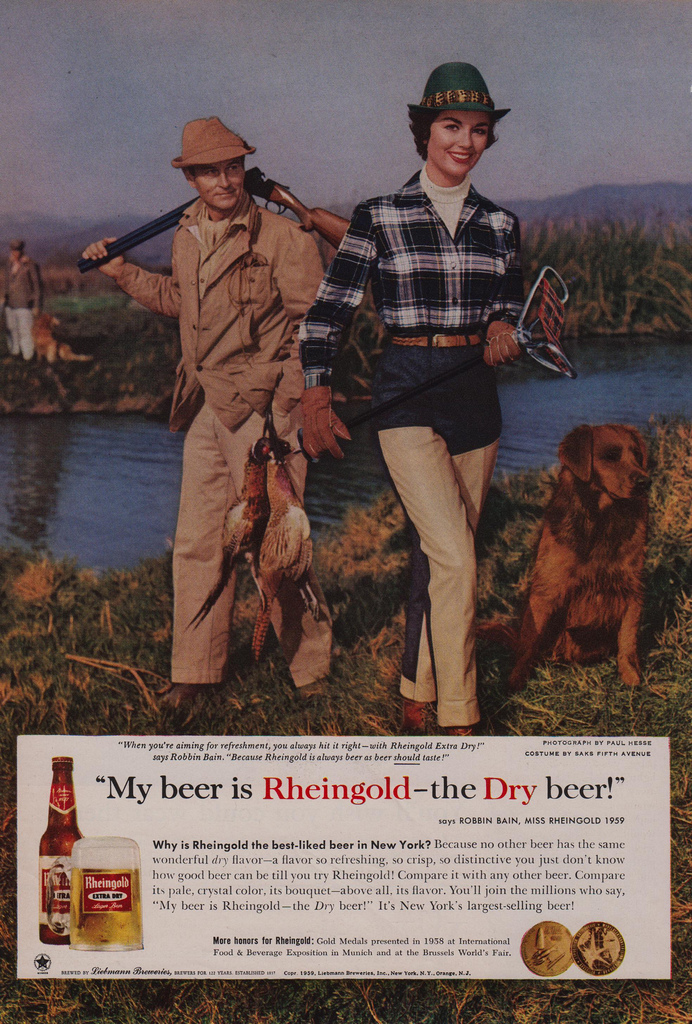
By Jay Brooks

Just when I think prohibitionists can’t possibly get any scarier, I found out something new to give me the willies. I saw a odd set of letters retweeted by the good nut jobs at Alcohol Justice yesterday; the letters in question were the IOGT. I figured if they were in bed with AJ they would be worth knowing about. I’m not sure how I missed this group. They’re not exactly a secret, despite having all the trapping of a secret society. The IOGT was originally the “International Order of Good Templars,” a temperance organization founded in the 1850s. They eventually changed their name to the International Organisation of Good Templars in the 1970s because they felt Organisation sounded less like a scary secret society than Order. They also dropped the secret rituals and, I assume, got rid of the secret handshake. It didn’t help, and that’s probably why today they just use the initials IOGT.

An 1868 membership certificate from a chapter in Michigan. Looks harmless enough.
Apparently, it’s “structure [was] modeled on Freemasonry, using similar ritual and regalia. Unlike many, however, it admitted men and women equally, and also made no distinction by race.” Except in the American South, of course, where folks naturally demanded there be separate lodges for black and white members. So you know they were good people. Nothing furthers a stated goal of “liberation of peoples of the world leading to a richer, freer and more rewarding life” by “promot[ing] a lifestyle free of alcohol and other drugs” like continuing racism after the abolishment of slavery.
In 1875, after the American Civil War, the American senior body voted to allow separate lodges and Grand Lodges for white and black members, to accommodate the practice of segregation in southern US states. In 1876, Malins and other British members failed in achieving an amendment to stop this, and left to establish a separate international body. In 1887 this and the American body were reconciled into a single IOGT.
Throughout the late 19th century, chapters were formed all over the world and today they’re headquartered in Sweden, where it’s known as the IOGT-NTO, and other hyphenated suffixes are used in the forty nations with a chapter.

Apparently they’re fine with perpetuating stereotypes of wine for women, beer for men.
Here in America, it’s IOGT-USA, where there are 21 local chapters in only five states. On the plus side, “women were admitted as regular members early in the history of the Good Templars. In 1979, there were 700,000 members internationally, though only 2,000 in the country of the IOGTs origin, the United States.” I didn’t see any more recent membership figures, so who knows how many Good Templars there are now in the 21st century.
They have a somewhat unintentionally comic petition up on a separate website, with the headline “United to Expose the Alcohol Industry.” They go on: “It tears families apart, trashes personal ambition and holds back developing countries. Still, no one has looked deeper into the alcohol industry and demanded that they take responsibility for their actions. It’s time we expose them.” Seriously, “no one has looked deeper into the alcohol industry and demanded that they take responsibility for their actions?” Isn’t that what the IOGT, and all of the other prohibitionist groups have been doing for well over 150 years? But now “it’s time we expose them?” Maybe it’s because their history is rooted in being a secret society, but what exactly is there to expose? What exactly is secret about the global beer industry that hasn’t been written about, endlessly dissected, debated and discussed?
Down a little farther on the petition page, they claim that the “alcohol industry still rule people and markets without being watched, examined or globally questioned by media or lawmakers.” Um, Alcohol Justice is doing just that; styling themselves as the “industry watchdog.” And they’re hardly alone. Countless organizations are keeping a careful watch on the alcohol industry. It’s one of the most tightly regulated industries in the U.S., and I suspect that’s true in most other places, too.
I get that you don’t like alcohol, and think everybody should just stop drinking it, but let’s not pretend this idea just occurred to you last week. Or that brewers are part of some secret cabal to ruin your world. Because really, it’s not “your” world, it’s “ours,” by which I mean “everybody’s.” And many of us like a nice beer, thank you very much. You don’t want to drink alcohol? Fine, don’t drink it. No one is telling you that you must, I only wish you’d extend us the same courtesy and stop telling us about every problem drinker, as if we’re all the same. There are troubled people everywhere, doing all sorts of bad things, many of them worse than drinking too much. Like virtually every aspect of human existence, there is good and bad, and everyone should have the right to choose their own path. For every anecdote about an alcoholic, there are 99, or 95, people who aren’t; good people who are drinking responsibly, holding down jobs, raising families and getting on with their lives. They don’t deserve to have you condemning them every chance you get.
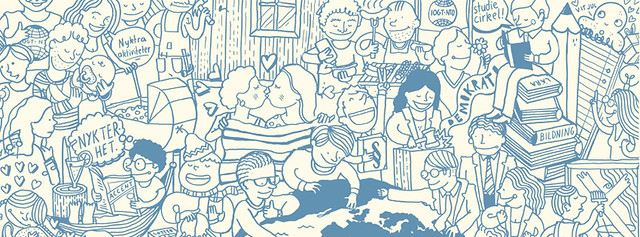
Examples of non-alcoholic fun. I have fun without alcohol all the time, but only in moderation.
By Jay Brooks
![]()
Space … the Final Frontier … for Beer. These are the voyages of the Starship Ninkasi. Its 8-year old mission: to brew strange new beers, to seek out new life and new civilizations to drink beer, to boldly brew where no man has brewed before.

Alright, it’s possible I’ve exaggerated a little, but Ninkasi Brewing in Eugene, Oregon announced their new Ninkasi Space Program, a collaboration with CSXT (Civilian Space eXploration Team), “a team of around 30 civilians interested in private spaceflight.” As a longtime space geek, it’s a pretty cool idea.
Mission One
NSP’s first task is to test the viability of yeast in space. This volatile organism, the living ingredient from which beer is born, requires precise conditions to thrive. Will 16 strains of brewer’s yeast survive Mission One, in which they are jettisoned outside Earth’s atmosphere on a rocket? Once we know, NSP will be one step closer to the ultimate brewery…in space.
Mission one will be launched later this month, around thirteen days from today, according to the countdown clock on the NSP website.
More from the press release:
“NSP is a very serendipitous project,” explains Nikos Ridge, CEO and co-founder of Ninkasi. “I don’t think you could have planned a more perfect pairing of beer and space geekery.”
Introduced through a mutual friend, Ridge met with Bruce Lee, of CSXT, at an amateur rocket launch competition in 2013 where the idea first came about.
“As a result of meeting Nikos, CSXT is pleased to include Ninkasi as a team member for the launch,” says Bruce Lee, principle and range safety officer for CSXT. “Launching brewer’s yeast into space will be an interesting experiment – something we’ve never done before.”
With almost a year of planning, NSP will finally get off the ground this month. Ninkasi’s lab technician, Dana Garves, and RapidMade, a Portland, Ore. company specializing in 3D printing, worked hand-in-hand to design and create a payload container built specifically to safely carry the 16 yeast strains into space and back to Earth for brewing—the first to do so.
“I couldn’t contain my excitement when I first heard of NSP,” says Garves. “We spent hours researching, developing and testing what we think will ensure that the yeast travels safely and returns to us healthy enough to brew with.”
After the launch, CSXT will retrieve the payload and immediately hand off the yeast samples to Garves who will analyze the yeast on-site with a microscope used in conjunction with her smartphone.
“Since we’ll be off-the-grid for the launch, I had to figure out a way to examine the samples remotely,” explains Garves. On-site, Garves will be testing for the viability of the yeast, analyzing the number of dead and live yeast cells.
If successful, the NSP team will return to the brewery with healthy yeast, ready to make its way into a very special beer for craft beer and space aficionados alike.
“Obviously, the fact that we’ve never launched yeast into space presents many challenges in itself even with months of planning,” says Ridge. “While we have confidence in our partners and the process, this is uncharted territory on several fronts and I can’t wait to see how it all unfolds on launch day.”
By Jay Brooks
![]()
If you’re interested in hangovers, or in avoiding them, believe it or not there’s a scientific organization devoted to them. The Alcohol Hangover Research Group, describes themselves as “an international expert group composed of active researchers in the field of alcohol hangover. The “goal of the AHR-Group is to elucidate the pathology, treatment and prevention of the alcohol hangover.”
The Atlantic recently had an interesting article, Hangovers, Why, all about a recent conference held in Seattle devoted to the science of hangovers, “a bit of a neglected field.” The article includes an interview with Richard Stephens, a member of the AHR-Group, and a professor of psychology at the UK’s Keele University, in which he reveals “some of the most surprising things scientists have learned recently about” hangovers.
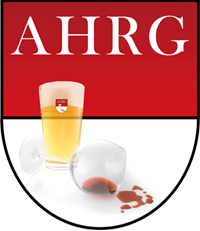
By Jay Brooks

Tuesday’s ad is another one for Rheingold Beer, this one also from 1959, and features Miss Rheingold from that year, Robbin Bain. In this ad, she’s holding a Dalmatian puppy in front of a scene of an old-fashioned fire truck. Even the fireman is wearing a retro firefighter’s uniform, and I wonder if that’s the puppy’s Mom on the truck with him?
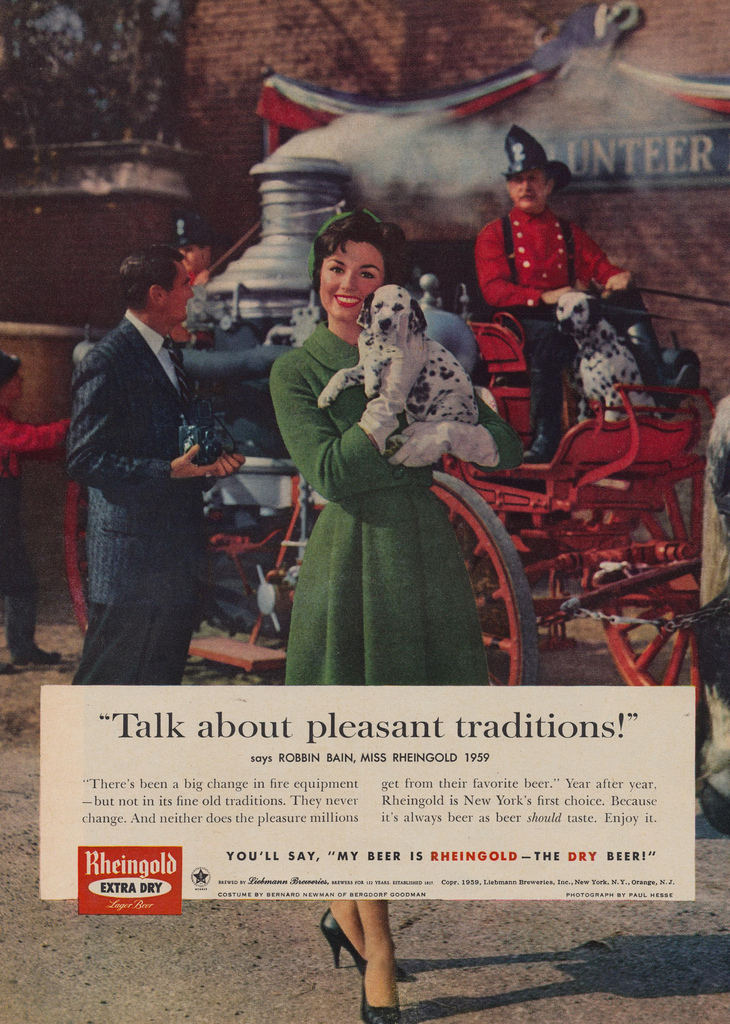
By Jay Brooks
